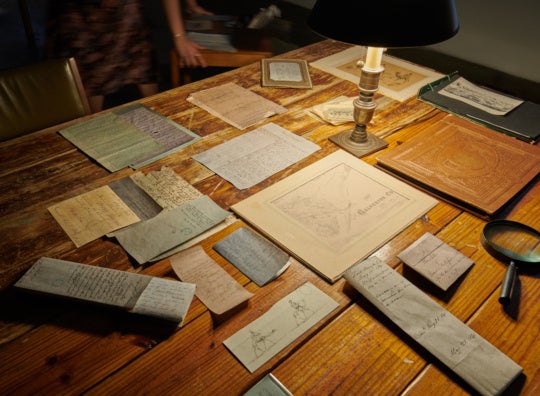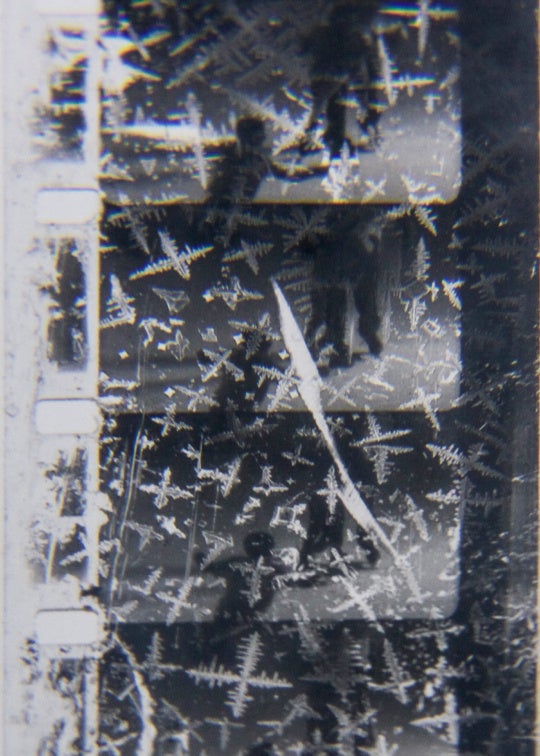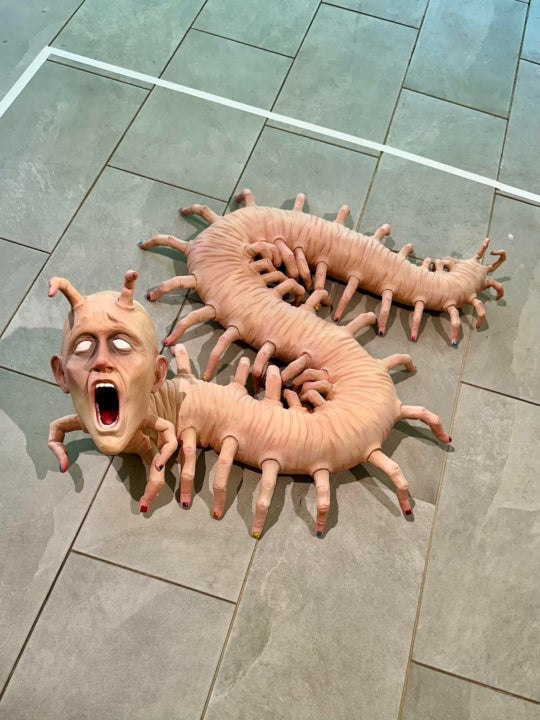
Amy Pleasant’s exhibition “re/form,” at Whitespace Gallery through February 15, presents a lineage of human history and responses to issues of identity, from ancient to modern times, caused by weighing one’s role in society against one’s place in nature. As she elaborates in her artist’s statement, this exhibition “invites the audience to consider how the history of the figure in art has shaped our understanding of the human experience.” Pleasant’s simplistic forms reference powerful symbols from African, Greek, and Roman cultures that represent fertility, civic duty, and interpersonal connection. The collage aesthetic of the images in “re/form” plays off of Pleasant’s illustrative, storybook style while placing the show’s cross-cultural themes on equal footing. This chronological disorientation refocuses history from its requisite linear narrative into a cyclical view. By portraying the past as a continuous series of growth, decay, and collapse, Pleasant introduces the similarities between ancient and modern struggles with identity.
Whether in prosperity or hardship, most people have remained aware of their debt to nature’s gifts. Fertility rites, for example, exemplify reverence to an organic world perceived as beyond human control. Handheld totems of faceless female figures, such as the Venus of Willendorf, often serve as icons in fertility rituals. The exaggerated breasts, hips, and pelvis on these icons emphasize a woman’s role in society as that of child-bearer.

Pleasant’s versions of fertility figures exaggerate their singularity of purpose. Silhouettes of impossible maternal figures show a woman composed mostly of numerous udder-like teats, or with two enormous breasts and nine heads. Direct sources, too, point to motherhood’s depiction in more developed cultures. A Tommaso de Modena painting titled Madonna and Child, unceremoniously printed onto computer paper, shows the Madonna donned in a smart blue dress, posing as if she knew she were having her portrait painted, with her left breast exposed to a suckling Jesus. This clash between the societal expectations of poise, grace, and beauty in a woman against the messy business of attending to a child, with its “primitive” display of nudity, plucks at the identity tension Pleasant describes in “re/form.”

Pleasant playfully turns men, too, into anonymous figures in her imagining of art historical relics. In one arrangement, she nods to the Greco-Roman tradition of immortalizing important men in portrait busts. One must circumnavigate a series of such busts set upon pillars of varying heights in the center of the gallery to realize that they portray no one. Two seem to be heads covered completely by hair, several have no defining features but are vaguely head-shaped lumps, and a couple are right-angled like an open book. It is as if the weight of time has worn down the visages and personalities of the men these busts represented, along with our collective memory of them, and turned them into forgettable historical anecdotes.
Humankind seems increasingly less secure in its socially defined roles as Pleasant guides the viewer into a more recent past. Domesticity becomes a shaky concept as people move homes more often, gender roles shift, and careers are frequently in flux. In Whitespace’s front room, the first that the viewer sees, Pleasant has grouped works that reference a more modern plight. A business-class hotel comes to mind in the ink on paper work Doors I; its five doors appear slightly off kilter, as if they exist in separate hallways, but all are visible at once and reveal shadowy figures inside the rooms. Trouble in the intimate realm appears in Bed 5, in which a haphazard layout of beds viewed from above suggests our current revolving door ethos of multiple relationships, sexual partners, and anxieties over who will help you fill your bed next.
Refreshingly, though, Pleasant provides a historical context for modernity instead of indulging the common navel-gazing instinct to ponder it as a set of problems unique to those currently experiencing them. Using gray-blues, translucent neutrals, and touches of pastel blue and pink to accentuate the simple figures and abundant negative space in her drawings and paintings, Pleasant repeats her colors and forms to rhythmically move the viewer through time. Faces in profile, like those seen on cameo pins, haunt the exhibition, representing societies in differing states of order and disarray. The ink drawings Untitled (Specks 1) and Untitled (Specks II) are loose arrangements of figures displayed in frames, as if to impose some afterthought of order. Similar figures are lined up as neatly as a military formation in the scroll-like Untitled (Rows III), a wall hanging that flows onto the floor.
By favorably comparing the struggles of modern identity to that of societies throughout history, Pleasant combats the Internet-age narcissism that, well, people can’t seem to stop whining about. She zooms out, far away from our millennial funk, to show that humanity has always had to reconcile its place in that unique space between the natural and man-made worlds.






